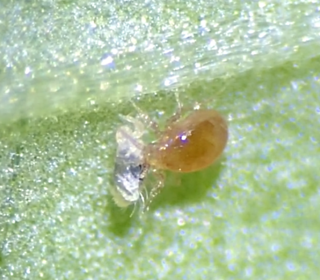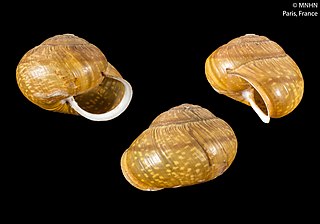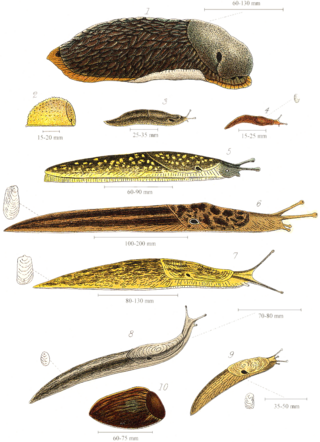
Mites are small arachnids. Mites span two large orders of arachnids, the Acariformes and the Parasitiformes, which were historically grouped together in the subclass Acari. However, most recent genetic analyses do not recover the two as each other's closest relative within Arachnida, rendering the group non-monophyletic. Most mites are tiny, less than 1 mm (0.04 in) in length, and have a simple, unsegmented body plan. The small size of most species makes them easily overlooked; some species live in water, many live in soil as decomposers, others live on plants, sometimes creating galls, while others are predators or parasites. This last type includes the commercially destructive Varroa parasite of honey bees, as well as scabies mites of humans. Most species are harmless to humans, but a few are associated with allergies or may transmit diseases.

Limax maximus, known by the common names great grey slug and leopard slug, is a species of slug in the family Limacidae, the keeled slugs. It is among the largest keeled slugs, Limax cinereoniger being the largest.
Parelaphostrongylus tenuis is a neurotropic nematode parasite common to white-tailed deer, Odocoileus virginianus, which causes damage to the central nervous system. Moose, elk, caribou, mule deer, and others are also susceptible to the parasite, but are aberrant hosts and are infected in neurological instead of meningeal tissue. The frequency of infection in these species increases dramatically when their ranges overlap high densities of white-tailed deer.

The black slug, Arion ater, is a large terrestrial gastropod mollusk in the family Arionidae, the round back slugs. Many land slugs lack external shells, having a vestigial shell. Most slugs retain a remnant of their shell, which is usually internalized, unlike other terrestrial mollusks which have external shells. Without such shells, slugs produce mucus, that may also contain toxins—to deter predators. Terrestrial slugs produce two other forms of mucus that facilitate locomotion and prevent death from drying. Such mollusks are hermaphroditic. Slugs most often function as decomposers but are also often omnivores. Arion ater is one such slug, decomposing organic matter, preying on other organisms, and consuming vegetative matter including agricultural crops. Native to Europe, the black slug is an invasive species in Australia, Canada, and the United States.

A gapeworm, also known as a red worm and forked worm, is a parasitic nematode worm that infects the tracheas of certain birds. The resulting disease, known as "gape", occurs when the worms clog and obstruct the airway. The worms are also known as "red worms" or "forked worms" due to their red color and the permanent procreative conjunction of males and females. Gapeworms are common in young, domesticated chickens and turkeys.

The Phytoseiidae are a family of mites which feed on thrips and other mite species. They are often used as a biological control agent for managing mite pests. Because of their usefulness as biological control agents, interest in Phytoseiidae has steadily increased over the past century. Public awareness of the biological control potential of invertebrates has been growing, though mainly in the US and Europe. In 1950, there were 34 known species. Today, there are 2,731 documented species organized in 90 genera and three subfamilies.

Arianta arbustorum, sometimes known as the copse snail, is a medium-sized species of pulmonate land snail in the family Helicidae.

Stratiolaelaps scimitus is a small (0.5 mm) light brown mite that lives in the top 1⁄2 inch (13 mm) layer of soil. As a natural predator of fungus gnat pupae and of the snail parasite Riccardoella limacum it is used by gardeners and snail breeders for biological pest control. Stratiolaelaps scimitus is also commonly used by reptile, amphibian and invertebrate keepers as a preventative or reactive measure against grain mites and reptile mites. Whereas most mite treatments are based on synthetic chemicals, predatory mites are used as a biological method of preventing and curing mite infestations.
Ehrlichia chaffeensis is an obligate intracellular, Gram-negative species of Rickettsiales bacteria. It is a zoonotic pathogen transmitted to humans by the lone star tick. It is the causative agent of human monocytic ehrlichiosis.

Slug, or land slug, is a common name for any apparently shell-less terrestrial gastropod mollusc. The word slug is also often used as part of the common name of any gastropod mollusc that has no shell, a very reduced shell, or only a small internal shell, particularly sea slugs and semi-slugs.

Cestoda is a class of parasitic worms in the flatworm phylum (Platyhelminthes). Most of the species—and the best-known—are those in the subclass Eucestoda; they are ribbon-like worms as adults, known as tapeworms. Their bodies consist of many similar units known as proglottids—essentially packages of eggs which are regularly shed into the environment to infect other organisms. Species of the other subclass, Cestodaria, are mainly fish infecting parasites.

Trombiculidae, commonly referred to in North America as chiggers and in Britain as harvest mites, but also known as berry bugs, bush-mites, red bugs or scrub-itch mites, are a family of mites. Chiggers are often confused with jiggers – a type of flea. Several species of Trombiculidae in their larva stage bite their animal host and by embedding their mouthparts into the skin cause "intense irritation", or "a wheal, usually with severe itching and dermatitis". Humans, being animals, are possible hosts.

The suprapedal gland or mucous pedal gland is an anatomical feature found in some snails and slugs. It is a gland located inside the front end of the foot of gastropods.

Angiostrongylus vasorum, also known as French heartworm, is a species of parasitic nematode in the family Metastrongylidae. It causes the disease canine angiostrongylosis in dogs. It is not zoonotic, that is, it cannot be transmitted to humans.

Hydrachnidia, also known as "water mites", Hydrachnidiae, Hydracarina or Hydrachnellae, are among the most abundant and diverse groups of benthic arthropods, composed of 6,000 described species from 57 families. As water mites of Africa, Asia, and South America have not been well-studied, the numbers are likely to be far greater. Other taxa of parasitengone mites include species with semi-aquatic habits, but only the Hydracarina are properly subaquatic. Water mites follow the general Parasitengona life cycle: active larva, inactive (calyptostasic) protonymph, active deutonymph, inactive tritonymph and active adult. Usually, larvae are parasites, while deutonymphs and adults are predators.

Cerithideopsis californica, common name the California hornsnail or the California horn snail, is a species of sea snail, a marine gastropod mollusk in the family Potamididae. This series was previously known as Cerithidea californica.

Phasmarhabditis hermaphrodita is a facultative parasitic nematode that can kill slugs and snails. It belongs to the family Rhabditidae, the same family as Caenorhabditis elegans.

Mites are small crawling animals related to ticks and spiders. Most mites are free-living and harmless. Other mites are parasitic, and those that infest livestock animals cause many diseases that are widespread, reduce production and profit for farmers, and are expensive to control.

The mating of gastropods is a vast and varied topic, because the taxonomic class Gastropoda is very large and diverse, a group comprising sea snails and sea slugs, freshwater snails and land snails and slugs. Gastropods are second only to the class Insecta in terms of total number of species. Some gastropods have separate sexes, others are hermaphroditic. Some hermaphroditic groups have simultaneous hermaphroditism, whereas some sequential hermaphroditism. In addition, numerous very different mating strategies are used within different taxa.

Gastropod-borne parasitic diseases (GPDs) are a group of infectious diseases that require a gastropod species to serve as an intermediate host for a parasitic organism that can infect humans upon ingesting the parasite or coming into contact with contaminated water sources. These diseases can cause a range of symptoms, from mild discomfort to severe, life-threatening conditions, with them being prevalent in many parts of the world, particularly in developing regions. Preventive measures such as proper sanitation and hygiene practices, avoiding contact with infected gastropods and cooking or boiling food properly can help to reduce the risk of these diseases.


















